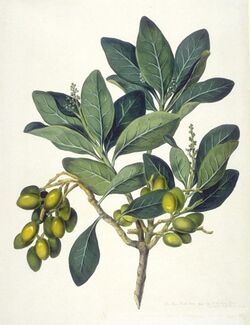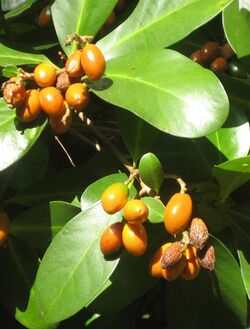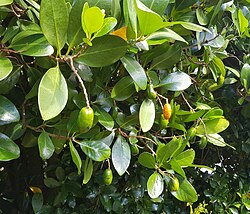Biology:Karaka (tree)
| Karaka | |
|---|---|

| |
| Illustration by John Frederick Miller | |
| Scientific classification | |
| Kingdom: | Plantae |
| Clade: | Tracheophytes |
| Clade: | Angiosperms |
| Clade: | Eudicots |
| Clade: | Rosids |
| Order: | Cucurbitales |
| Family: | Corynocarpaceae |
| Genus: | Corynocarpus |
| Species: | C. laevigatus
|
| Binomial name | |
| Corynocarpus laevigatus J.R.Forst. & G.Forst., 1776
| |
Karaka or New Zealand laurel (Corynocarpus laevigatus) is an evergreen tree of the family Corynocarpaceae endemic to New Zealand. It is common throughout the North and South Islands to Banks Peninsula (43°45′S) and Ōkārito (43°20′S), on the Three Kings Islands, on Raoul Island in the Kermadecs, and on the Chatham Islands.[1] It is widespread in coastal habitats,[2] often forming a major component of coastal forest, though it rarely dominates. Most botanists consider it to be native only to the northern half of the North Island, having been planted elsewhere by Māori near former village sites, and subsequently spread by birds. The common name karaka comes from the Māori language, and is also the Māori term for the colour orange, from the colour of the fruit. In the Chatham Islands, it is called kōpī, its name in the Moriori language. It is naturalised and considered invasive in Hawaii.
Description

Karaka is a leafy canopy tree with erect or spreading branches. It grows to heights up to 15 m and has a stout trunk up to 1 m in diameter. The thick, leathery leaves are glossy, dark green above and paler beneath, 50–200 mm long, and 30–70 mm wide with petioles 10–15 mm long. In winter and spring (August to November), karaka produces stout, erect panicles of tiny flowers. Individual flowers are 4–5 mm in diameter and greenish-cream to off-white or pale yellow. The fruit is an ellipsoid to ovoid drupe 25–46 mm long, with pale yellow to orange flesh, containing a single seed.[1] The fruit ripens in summer and autumn (January to April) and the seeds are mostly dispersed by columbiform birds which eat the fruit.
Ecology
This evergreen tree is a popular place for smaller birds to sleep during the winter. It is of great value to birds and other fauna, including invertebrates that feed on the fruits and disperse the seeds. The ability to bear fruit in early summer (January) gives this plant an important ecological value, being a good food source for many species, especially birds, at a time when most other berries are not yet ripe. Centuries ago the seeds would have been dispersed by moa and possibly other large birds. Today only kererū are known to disperse karaka seeds, although there are reports of blackbirds pecking at fruits carrying them away from the tree if disturbed. Most of the seed crop lies beneath the tree where carpets of shade suppressed seedlings grow.
Fruiting
There is a marked difference of quantity of fruit between the male and female plants. Male plants produce some sparse fruit only. [3] The flowers are also a way of distinguishing between male and female plants. [4]
Cultivation
Karaka may be easily grown from fresh seed, but cuttings are very difficult to strike. Young plants are frost-tender and sensitive to cold. The tree often naturalises in suitable habitats. It is common in cultivation and widely available for sale both in New Zealand and in suitable climates elsewhere.[1] It was one of the most grown food crops by pre-European Māori (alongside kūmara (sweet potato) and aruhe (bracken fern root), who ate the drupe and seed after a long detoxification process.[5][6]
Every autumn (March to May), pre-European Māori would collect the seeds dropped from the coastal karaka trees. The seeds would be placed in open-weave kete, washed in rivers to remove the outer pulp, afterwards baked and sun dried, a process that would remove toxicity from the seeds.[5] Properly prepared karaka kernels would keep for 2–3 years.[5]
Toxicity and uses
The pulp of ripe fruit is edible, sweet and aromatic, but the fresh kernels contain the toxic alkaloid karakin. Accounts from the 19th century record that extensive processing was used by Māori to convert the kernels to an edible form, and mention that if the processing was not done with the greatest care, poisoning would result with symptoms including violent convulsions and severe muscle spasms which could leave the limbs permanently fixed in contorted positions. Death occurred in a few cases.[7]
The berries are toxic if ingested by dogs and may result in death.[8][9] There is also evidence from beekeepers that the flowers may be narcotic or toxic to bees, causing bee loss and resulting in lower honey production.[10]
Culture
On the Chatham Islands this tree (locally known as kopi)[11] has played a distinguished role in the history of Moriori people: the soft bark of these trees has been used for making dendroglyphs.[12] A report in 2000 noted the existence of 147 kopi trees with dendroglyphs, though some may not have been authentically Moriori.[13]
References
- ↑ 1.0 1.1 1.2 "Corynocarpus laevigatus". New Zealand Plant Conservation Network. 15 January 2012. http://www.nzpcn.org.nz/flora_details.aspx?ID=1762.
- ↑ "The New Zealand Dictionary". The New Zealand Dictionary. New House. 1994.
- ↑ Garnock-Jones PJ, Brockie RE, FitzJohn RG. Gynodioecy, sexual dimorphism and erratic fruiting in Corynocarpus laevigatus (Corynocarpaceae). Australian Journal of Botany. 2007;55(8):803-808. doi:10.1071/BT07054.
- ↑ PJ Garnock-Jones. Theobrominated. Fruiting karaka; 2023-01-07 [Retrieved 2024-01-07].
- ↑ 5.0 5.1 5.2 Colenso, William (1880). "On the vegetable food of the ancient New Zealanders before Cook's visit". Transactions and Proceedings of the Royal Society of New Zealand 13: 3–38. https://paperspast.natlib.govt.nz/periodicals/TPRSNZ1880-13.2.6.1.1.
- ↑ Sawyer, John; McFadgen, Bruce; Hughes, Paul (March 2003). "Karaka (Corynocarpus laevigatus J.R. et G. Forst.) in Wellington Conservancy (excluding Chatham Islands)". DOC Science Internal Series (Department of Conservation, New Zealand) 101: 1–26. ISBN 0-478-22387-0. https://www.doc.govt.nz/documents/science-and-technical/dsis101.pdf.
- ↑ Skey, W. (1871). "Preliminary Notes on the Isolation of the Bitter Substance of the Nut of the Karaka Tree (Corynocarpus lævigata)". Transactions and Proceedings of the New Zealand Institute 4: 316–321. http://rsnz.natlib.govt.nz/volume/rsnz_04/rsnz_04_00_002360.html. Retrieved 22 May 2013.
- ↑ Fawcett, Stephanie (29 Feb 2012). "Danger in the garden" (in en). https://www.stuff.co.nz/auckland/local-news/eastern-courier/6497910/Danger-in-the-garden.
- ↑ Anderson, Antonia; Pratt, Ciara (2 February 2015). "Toxic karaka fruit can kill dogs" (in en). https://www.stuff.co.nz/auckland/local-news/western-leader/65682781/toxic-karaka-fruit-can-kill-dogs.
- ↑ "How Real Is The Risk To Bees From Karaka?". 19 October 2020. https://www.nzbees.net/forums/topic/14218-how-real-is-the-risk-to-bees-from-karaka/.
- ↑ Chatham Islands - Te Ara encyclopedia http://www.teara.govt.nz/en/chatham-islands/page-3
- ↑ Wondermondo armchair guide to world attractions http://www.wondermondo.com/Countries/Au/NZ/Chatham/Hapupu.htm
- ↑ Fraser W. Jopson and Craig R. McKibbin, "Moriori tree carvings, Chatham Islands: Close-range photogrammetric record and survey," Department of Conservation Technical Series 20 (September 2000), p. 8.[1]
External links
Wikidata ☰ Q5477982 entry
 |



